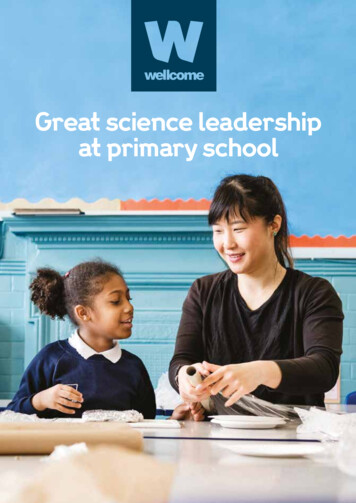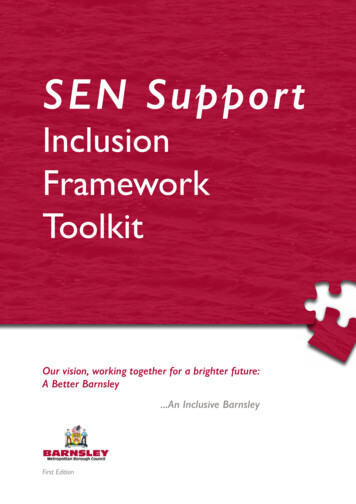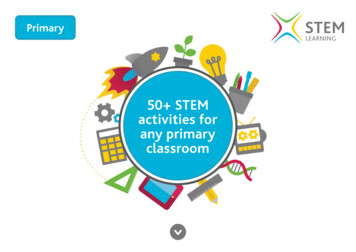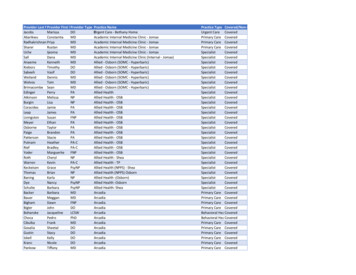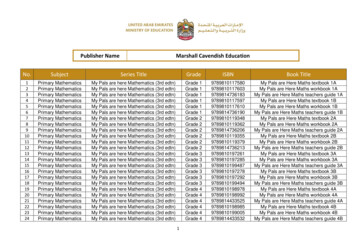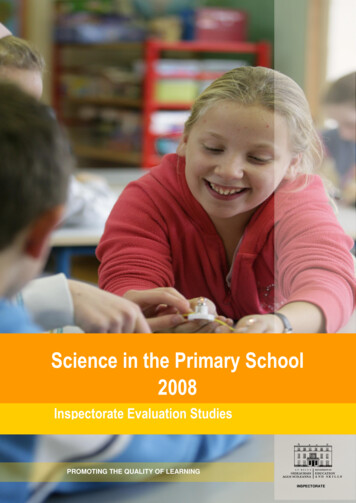
Transcription
Science in the Primary School2008Inspectorate Evaluation StudiesPROMOTING THE QUALITY OF LEARNINGiINSPECTORATE
The Inspectorate wishes to thankWhitechurch National School, Rathfarnham Dublin 16for permission to use the cover photograph. 2012 Department of Education and SkillsPublished byEvaluation Support and Research UnitInspectorateDepartment of Education and SkillsMarlborough StreetDublin 1This report and others in the series may be accessed atwww.education.ieii
ContentsForewordiiiChapter 1Introduction1Chapter 2Evaluation methodology9Chapter 3Quality of planning for Science14Chapter 4Quality of teaching in Science23Chapter 5Quality of learning in Science32Chapter 6Main findings and recommendations41References46i
List of TablesPageTable 1.1The content strands of the science curriculumTable 2.1Sample task for senior infants11Table 2.2Sample task for sixth class12Table 2.3Quantitative terms used in this report13Table 2.4Levels of the quality continuum and corresponding qualitative terms13Table 3.1Summary of findings regarding whole-school planning17Table 3.2Inspectors’ evaluation of classroom planning18Table 3.3Summary of findings regarding classroom planning and preparation20Table 4.1Summary of findings regarding classroom atmosphere and management25Table 4.2Inspectors’ evaluation of aspects of teaching26Table 4.3Summary of findings regarding the quality of teaching in Science28Table 5.1Performance of pupils in tasks from each strand32Table 5.2Sample task from Human life33Table 5.3Sample task from Plant and animal life34Table 5.4Sample task from Magnetism and electricity36Table 5.5Sample task from Properties and characteristics of materials36Table 5.6Pupil performance on tasks to assess procedural understanding383List of FiguresPageFigure 4.1Inspectors’ evaluation of aspects of classroom management24Figure 4.2Inspectors’ evaluation of the overall quality of teaching25Figure 4.3Inspectors’ evaluation of aspects of assessment29Figure 5.1Pupils’ performance on tasks from Living things33Figure 5.2Pupils’ performance on tasks from Forces35Figure 5.3Pupils’ performance on tasks from Materials36Figure 5.4Pupils’ performance on tasks from Environmental awareness and care37ii
ForewordThe inclusion of Science in the Primary School Curriculum (1999) brought a major changeto the curriculum of primary schools and reflected the importance that science andtechnology have in many aspects of our daily lives, at work, at school and at home. Ourdependence on science and technology requires that all pupils develop a high level ofscientific literacy. The primary Science curriculum offers schools a comprehensiveprogramme from infants to sixth class. It provides a very good foundation for the study ofscience subjects in the post-primary setting. Most importantly, it cultivates a positiveattitude to science and provides pupils with opportunities to experience the excitement ofworking as a scientist.Science in the Primary School reports on the implementation of the 1999 sciencecurriculum as this was in evidence during inspections carried out in forty primary schoolsduring 2007. The evidence indicates that a significant number of primary schools wereexperiencing success in many aspects of the science curriculum and that teachers andpupils were benefiting from the broad and balanced range of learning experiences outlinedin the curriculum. Inspectors found evidence that national in-service supports werebeneficial and that many teachers had engaged in further professional development in thearea of science. They also reported that schools had made good use of the fundingavailable for the purchase of science materials and equipment.The report also outlines areas for improvement. In particular, inspectors found that schoolsneeded to provide more regular opportunities for pupils to engage in problem solving andopen-ended investigations and to develop the skills listed in the Working scientifically andDesigning and making sections of the curriculum. Inspectors were also of the view thatschools needed to engage in whole-school planning for the purpose of improving teachingand learning rather than for the purpose of satisfying the requirements of educationallegislation. The report also contains recommendations regarding the incorporation ofassessment into the teaching and learning process and regarding the integration intoschools’ science programmes of the many science-related initiatives that have beenintroduced into schools in recent yearsThe Inspectorate has a specific contribution to make in evaluating the quality of provisionin schools, in advising schools and teachers and in providing policy advice and directionfor the system in general. This report makes a significant contribution in each of theseareas and presents findings and recommendations that will be of interest to teachers,parents, support services, teacher educators and policy makers.iii
Chapter 1Introduction1.1Evaluation of curriculum implementation in ScienceThe introduction of a broad science programme for all classes was one of the key changes inthe revised Primary School Curriculum of 1999 (Department of Education and Science,1999a). This report presents the findings of an evaluation carried out in forty primary schoolsduring 2007 that focused on how effectively the science curriculum was being implemented inclassrooms and in schools.1.2Science in the Primary School CurriculumScience was included in the Primary School Curriculum in 1999 as one of three subjects inthe area of Social, Environmental and Scientific Education (SESE). Although some focus onElementary Science had been included in the 1971 curriculum for senior pupils, the 1999curriculum is significantly more comprehensive than the previous one in a number of respects.The curriculum requires teachers to implement the science programme from junior infants tosixth class. It sets out a minimum weekly time allocation for each subject. Science is allocatedforty-five minutes per week in infant classes and one hour per week in all other classes. Thiscontrasts with the 1971 curriculum, in which Elementary Science was included as a subject infifth and sixth classes only. In practice, this element of the 1971 programme was not widelyimplemented.The science curriculum is structured so that pupils can learn about the biological and physicalaspects of the world in four content strands: Living things, Energy and forces, Materials, andEnvironmental awareness and care. The 1971 curriculum, in contrast, offered a limited rangeof topics for senior classes only.A key element of the 1971 Environmental Studies programme was ‘nature study’, whichfocused on animal and plant life in all classes. This programme was absorbed into the sciencecurriculum under the strands, Living things and Environmental awareness and care. However,the curriculum now requires pupils to adopt a scientific approach to the study of living things.While the 1971 curriculum emphasised the importance of learning through activity anddiscovery, this emphasis is more central to the 1999 curriculum. The curriculum now aims todevelop scientific skills as well as understanding. Practical investigation is central to scientificactivity and the curriculum emphasises the importance of providing pupils with opportunities totest and develop their ideas.1
The science curriculum includes two further new emphases. Pupils in every class areintroduced to technology through a specific technology section entitled Designing and making.Additional emphasis is also placed on the interrelationship between science, technology andthe environment. As a result, the curriculum incorporates the strand unit Science and theenvironment which aims to develop the pupils’ understanding and appreciation of the ways inwhich science and technology can help us to use the Earth’s resources for the social, culturaland economic benefits of humanity.1.3Structure of the science curriculumThe science curriculum aims to develop two types of understanding among pupils: conceptualunderstanding and procedural understanding.Conceptual understanding refers to the pupils’ knowledge of the biological and physicalaspects of the world. Procedural understanding refers to the pupils’ understanding of scientificprocedures. These two forms of understanding are not developed independently. In particular,a secure understanding of scientific procedures is necessary for the on-going development ofconceptual understanding.Conceptual understandingPupils’ conceptual understanding is developed through the study of four areas or strands:Living things; Materials; Energy and forces; and Environmental awareness and care. Eachstrand includes several topics called strand units. These are shown in Table 1.1.Teachers are required to complete work from each strand every year and work from eachstrand unit over every two-year period. The curriculum is often described as having a spiralstructure. This refers to the fact that, as pupils progress from class to class, they revisit eachtopic, developing and refining their understanding. In the strand unit Forces, for example,pupils in the infant classes are enabled to predict whether an object will float or sink on thebasis of the material from which it is made. In first and second class, these pupils learn thatthe shape of the object is also a factor in floating and sinking. In third and fourth classes, theydiscover that objects float differently in fresh and salt water. In fifth and sixth classes thepupils begin to understand floating and sinking in terms of gravity and the opposing forceexerted by water.2
Table 1.1: The content strands and strand units of the science curriculumLiving thingsEnergy andforcesMaterialsEnvironmentalawareness andcareInfantsFirst and SecondThird and FourthFifth and SixthMyselfMyselfHuman lifeHuman lifePlants and animalsPlants and animalsPlants andanimalsPlants and tHeatHeatHeatMagnetism andelectricityMagnetism andelectricityMagnetism andelectricityMagnetism andelectricityForcesForcesForcesForcesProperties andcharacteristics ofmaterialsProperties andcharacteristics ofmaterialsProperties andcharacteristics ofmaterialsProperties andcharacteristics ofmaterialsMaterials andchangeMaterials andchangeMaterials andchangeMaterials andchangeCaring for myselfand my localityCaring for myselfand my ssScience and theenvironmentScience and theEnvironmentCaring for theEnvironmentCaring for theenvironmentProcedural understandingPupils’ procedural understanding is developed through two skills sections: Workingscientifically and Designing and making.The curriculum emphasises thatwhat distinguishes a scientific activity from other forms of enquiry is not thesophistication of the ideas used but the process through which these ideas aredeveloped. (Department of Education and Science, 1999b, p.2)The section of the curriculum entitled Working scientifically presents a procedural model ofhow scientists work and outlines the various skills and knowledge that are required. The skillsto be developed by this section of the curriculum are Questioning Observing Predicting Investigating and experimenting Estimating and measuring3
Analysingo Sorting and classifyingo Recognising patternso InterpretingRecording and communicating results.The development of the pupils’ understanding of what constitutes ‘a fair test’ is particularlyimportant. Pupils learn that in order for a test to be fair, there are always certain things thatmust be kept the same. For example, when testing various brands of kitchen paper to find outwhich is most absorbent, pupils learn that the size of the sheet of paper and the volume ofwater used are among the variables that must be controlled if the results are to be accurate.The curriculum envisages that pupils in middle and senior classes will be enabled to designand conduct their own investigations, controlling relevant variables. This involves pupils informulating the question to be answered by the investigation and making key decisions aboutthe investigative procedure to be followed. The skills of Working scientifically are included alsoin the Geography curriculum under the heading Geographical investigation skills.Designing and making is the technology component of the curriculum. Designing and makingaims to provide children with an understanding of the technological process and the ability toapply their scientific skills and knowledge in solving practical problems. Exploring, planning,making and evaluating are the four key elements in Designing and making. It is important thatpupils are enabled to work independently in this process, particularly in the middle and seniorclasses. Designing and making “should provide the children with the scope to generate theirown designs and the freedom to devise their own solutions to problems” (Department ofEducation and Science, 1999b, p.134).1.4Principles of learning in the science curriculumThe science curriculum and the accompanying Teacher Guidelines highlight certain keyprinciples that form the basis for effective learning and teaching in Science. These principlesprovided a significant focus for this evaluation.a) Children’s ideas as the starting pointThe constructivist philosophy underpins the science curriculum and it emphasises that thechild’s existing knowledge and experience form the base for subsequent learning. All scienceactivities should begin with the teacher eliciting the pupils’ existing ideas on the topic.Meaningful learning occurs when the pupils construct their understanding by modifyingtheir existing ideas in the light of new insights gained from scientific investigations.Thus, Science may be seen as the active process of the personal construction ofmeaning and understanding. (Department of Education and Science, 1999a, p.7)4
The teacher’s main role, therefore, is to identify the pupils’ existing ideas on a particular topicand to enable them to test and develop these ideas in a scientific manner. The assessment ofchanges in pupils’ concepts and skills is an on-going feature of the constructivist approach.b) Practical investigationsThe importance of activity and discovery methods has been accepted as a key principle inIrish primary education since 1971. In the context of Science, it means that pupils should begiven opportunities to test and develop their ideas about the physical world through hands-on,practical problem-solving activities and open-ended investigations.c) The local environmentThe child’s immediate environment provides the main context for learning across all fourstrands of the curriculum. The local environment is a particularly valuable resource forlearning in Living things. Local habitats are the most appropriate place to start learning aboutplants and animals. Schools are encouraged to use the habitats that are available locally andto create new habitats in the school grounds. The environment should also be developed andused as a resource for learning in the other three content strands and the skills sections of thecurriculum.d) Balance between knowledge and skillsThe emphasis placed on the development of the pupils’ understanding of science conceptsshould be balanced by an equal emphasis on the development of procedural understandingand skills. The Working scientifically and Designing and making sections of the curriculumprovide the basis for much of this work. This balance between knowledge and skills is afeature of all subjects in the Primary School Curriculum.e) Integration and linkageYoung children don’t see their world as divided into curricular subjects. At school, learning canbe more effective when topics or ideas are dealt with simultaneously in more than onesubject. Teachers are expected to plan units of work that make links between different areasand subjects, especially between the SESE subjects: Science, History and Geography.1.5The context in which Science is taughtThe introduction of Science as a subject in the Primary School Curriculum in 1999 posed aconsiderable challenge for the school system. These challenges related to teachers’ ownknowledge of Science, the need for learning in the subject to be activity based and theprovision of the necessary resources and professional-development opportunities that wouldaddress knowledge of the subject matter and pedagogical approaches to teaching Science.5
1.5.1 Primary teachers’ confidence and competence regarding ScienceTraditionally, the interests and strengths of Irish primary teachers were considered to be in theareas of language and the arts, rather than Science. Some of the providers of initial teachereducation (ITE) have had science courses in place for many years. Since 1999, all providershave included science education to some extent in their ITE programmes. However, aconsiderable number of the teachers working in Irish primary schools at the time of theevaluation had not received any pre-service training in science education.To date, student teachers also have had limited opportunities to pursue Science as a specialarea of study during their initial teacher education. In 2002, The Report of the Task Force onthe Physical Sciences (Department of Education and Science, 2002a) recommended that areview of how initial teacher education prepares primary and post-primary teachers to teachScience should be undertaken. The report observed that only a minority of primary teachershad taken a physical science subject in the senior cycle at second-level, and recommendedthat priority be given to the physical sciences in continuous professional development forprimary teachers.The publication by the Teaching Council in June 2011 of Initial Teacher Education: Criteriaand Guidelines for Programme Providers set out, for the first time, common learningoutcomes for all graduates of ITE programmes in Ireland. Revised ITE programmes were dueto be offered by all of the programme providers in autumn 2012. Science is not defined as amandatory element of such programmes and there remains considerable variation betweenthe providers regarding the time allocated to Science and the content and model of delivery ofscience courses.1.5.2 Teaching approachesIn 2002 the Inspectorate of the Department of Education and Skills1 published Fifty SchoolReports: What the Inspectors Say (Department of Education and Science, 2002b). This wasbased on an analysis of evaluation reports on the work of primary schools in the school year2001-2002. In discussing teaching approaches generally, the report stated that there wasinsufficient use of group teaching and differentiated learning. It was reported also that therewas an over-emphasis on textbooks. Each of these presented particular challenges to theimplementation of practical activity-based approaches. When commenting specifically onScience, Fifty School Reports (Department of Education and Science, 2002b) observed thatthe content strands Living things and Environmental awareness and care had drawn the mostfavourable comments from inspectors. The report expressed concern about insufficientactivity-based learning in Science and the absence of formal assessment of pupilachievement in Science.1Formerly the Department of Education and Science, and hereinafter ‘the Department’6
1.6Support for implementation1.6.1 Science: Teacher GuidelinesA range of actions was taken by the Department to support the implementation of the sciencecurriculum. In addition to copies of the science curriculum, all teachers received TeacherGuidelines for the subject, which contained extensive practical advice regarding theimplementation of the curriculum. The Teacher Guidelines suggested approaches to planningfor Science at whole-school and classroom level. They offered advice on how to approach thevarious strands, strand units and skills sections of the curriculum and included over fortyexemplars of effective practice. The Teacher Guidelines also contained advice on theequipment and materials that were required to implement the curriculum.1.6.2 Support servicesAn extensive programme of professional-development opportunities for teachers was fundedby the Department, to support them in the implementation of the science curriculum. Theplanning and delivery of this support recognised that the introduction of the science curriculumwas a major innovation and a phased programme was used to build capacity in the subjectamong teachers and schools. From September 2000 to June 2002, the Primary CurriculumSupport Programme (PCSP) provided support for almost 300 schools as part of adevelopmental project to build capacity for the implementation of the science curriculum. Twoone-day in-service seminars were provided for all primary-school teachers in the 2002-2003school year. Schools were also allowed to close for one day to enable the teachers to engagein whole-school planning for Science. The School Development Planning Service (SDPS)provided seminars to teachers on planning matters.2Schools were required to commence implementation of the science curriculum in September2003. The PCSP provided a team of cuiditheoirí (curriculum advisors) to give advice andsupport, on request, to schools. In the first year of implementation, there were twelvecuiditheoirí dealing solely with Science. From 2004 on, each of the cuiditheoirí providedsupport for more than one subject. The level of cuiditheoir support available for Science variedfrom year to year. In the school year 2006/2007, there were thirteen cuiditheoirí who hadScience as one of their subjects. Since the support services were amalgamated in 2008schools have not been able to receive subject-specific support in Science.1.6.3 Funding for science equipmentMost of the equipment and materials required for Science are non-specialist items that areeasily obtained and can be used for practical activities in other subjects. Nevertheless, in2In September 2008 the Primary Curriculum Support Programme (PCSP) and the School DevelopmentPlanning Service-Primary (SDPS) were subsumed into the Primary Professional Development Service(PPDS). This, in turn, was subsequently subsumed into the Professional Development Service for Teachers(PDST).7
September 2004 the Department issued a science grant of 7 million to primary schoolstowards the purchase of science equipment. Each school received 1000 plus 100 per pupil.1.6.4 Science initiatives and projects in primary schoolsIrish primary schools have opportunities to participate in a range of science-related projectsand initiatives. Many of these involve the schools in collaboration with local science-basedindustries. Some of the projects provide induction days and other valuable professionaldevelopment opportunities for the participating teachers. The following is a small sample ofthe projects that attract high levels of participation from schools all around Ireland.Discover Primary Science and Maths is a project of Discover Science & Engineering (DSE),Ireland's national science-promotion programme. It facilitates teacher training in generalprimary science, and provides teachers with useful online resources and classroom activitypacks. At the time of writing over 3,100 primary schools and their teachers were participatingin activities including hands-on induction days which were hosted throughout the country incolleges of education, institutes of technology, universities and education centres.The Science, Technology and Engineering Programme for Schools (STEPS), which wasset up in 2000, aims to foster an enthusiasm for science and engineering while also promotingengineering as a career choice. It is particularly supportive of the Designing and makingsection of the curriculum.The An Taisce Green Schools Programme aims to increase awareness of environmentalissues through classroom studies and to transfer this knowledge into positive environmentalaction in the school and also in the wider community. The schools participate by reducing litterand waste, conserving energy and water and promoting a safe means of walking and cyclingto school. At the time of writing, over 3,500 primary, secondary and special schools in Irelandwere participating in the programme and 2308 schools had been awarded the Green Flag.1.7Report structureThe Inspectorate’s evaluation of Science in the primary school was designed to examine theextent to which the aims and objectives of the Primary School Curriculum were beingachieved in schools. Chapter 2 describes the procedures and methodology employed togather and analyse data. Chapter 3 outlines the findings in relation to whole-school planningand classroom planning for Science. Chapter 4 reflects on the quality of teaching andassessment practices in Science, with an evidence base consisting of inspectors’observations of lessons, interviews and document reviews. Chapter 5 presents the findings onpupils’ learning in Science. Chapter 6 provides a summary of main findings andrecommendations.8
Chapter 2Evaluation methodology2.1Purpose of the evaluationThe Inspectorate’s evaluation aimed to answer two key questions:1. Is the science curriculum being implemented effectively?The evaluation sought to ascertain the quality of teaching and learning in Science. Inparticular, the evaluation attempted to establish if pupils were achieving the objectivesof the science curriculum. Therefore, as well as gathering evidence of the teachingapproaches used, the evaluation team gathered data about pupils’ achievement inscience tasks.2. What actions would improve the quality of learning and teaching in Science?The evaluation sought to identify how the teaching of Science could be improved. Theprimary source of data was the evidence-based judgements made by inspectors inclassrooms and schools. This was supplemented by conducting interviews withprincipals, teachers and science co-ordinators in each of the schools evaluated togenerate their views of Science and its implementation in schools.2.2Schools participating in the evaluationThe evaluation was conducted during 2007 in a sample of forty schools, in place of wholeschool evaluations (WSE) that were scheduled to take place in these schools. The schoolevaluations had a dual focus, with Mathematics being evaluated also. The selected schoolswere informed of the focus of the inspection three weeks prior to the commencement of the inschool evaluation. The sample included a mix of urban and rural schools, and co-educationaland single-sex schools, as well as several schools that were designated disadvantaged. Inorder to ensure that a sufficiently large evidence base was used for the evaluation, all of theschools had at least five mainstream class teachers. Teaching and learning in Science wasobserved and evaluated in 215 classroom settings.9
2.3The in-school evaluation2.3.1 Research activitiesEvidence was gathered through Completion of a school-information questionnaire by the school principal Examination of planning and recording for science at whole-school level andclassroom level Inspection of school resources for Science Interviews with the school principal, science co-ordinator and a sample of classteachers Observation of science lessons Administration of pupil-assessment tasks.A set of evaluation tools (including interview and observation schedules) was produced tosupport the inspectors in these activities. Two schools were evaluated in a preliminary phaseof the evaluation in autumn 2006. On the basis of this experience, research activities weremodified slightly in advance of the main phase of evaluation activity.2.3.2 Observation of science lessonsA preliminary meeting was convened with the teachers in each school prior to the evaluation.At this meeting details of the evaluation, including the specific strands of the curriculum thatwould be evaluated in each class, were discussed with the staff. To ensure that there wasbreadth and balance in the sample of lessons seen, each teacher was asked to prepare alesson from a particular content strand. A quarter of all teachers observed were asked toprepare a lesson in Designing and making.In schools with eight class teachers or fewer, a science lesson was observed in everyclassroom. A Mathematics lesson was also observed in each classroom by a secondinspector. In schools with nine or more class teachers, a science lesson was observed in atleast half of the classrooms and Mathematics was evaluated in the remaining classes. Eachteacher observed was given informal feedback by the inspector after the lesson.2.3.3 Tasks to assess pupil achievementA range of pupil tasks was administered as part of the evaluation. These tasks did notconstitute a standardised test and the outcomes should therefore be treated with a degree ofcaution. A standardised test to measure achievement in Science is not available for Irishprimary school pupils at present and the standardisation of the tasks was beyond the remitand resources of the Inspectorate evaluation. However, the tasks used were based on theobjectives of the Primary School Curriculum and provided some indication of the extent towhich pupils had achieved the curriculum objectives.10
This was the first Inspectorate evaluation in which there was extensive use of pupil tasks toassess achievement of specific curriculum objectives. Comparable evidence for Science orother subjects of the Primary School Curriculum does not exist. It was possible, however, tocompare evidence regarding pupil achievement in different strands and strand units andbetween content strands and skills sections. The data presented here also provides a usefulreference point for future studies.Finally, by directing attention towards the extent to which pupils were demonstratingachievement of curriculum objectives the evaluation also provided schools with a reminder ofthe importance of basing their programmes, lessons, activities and proje
ii List of Tables Page Table 1.1 The content strands of the science curriculum 3 Table 2.1 Sample task for senior infants 11 Table 2.2 Sample task for sixth class 12 Table 2.3 Quantitative terms used in this report 13 Table 2.4 Levels of the quality continuum and corresponding qualitative terms 13 Table 3.1 Summary of findings regarding whole-school planning 17



